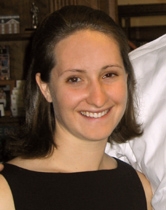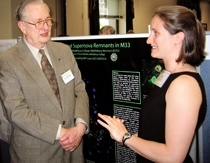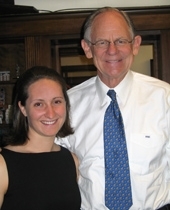Emily McNeil observes glowing clouds of debris from star explosions

MIDDLEBURY, VT.- Senior Emily McNeil has loved outer space for as long as she can remember. She thinks nothing can beat the view from the state-of-the-art observatory atop Middlebury College’s science facility. Seven stories high and 40 miles from any large city, the building provides the perfect spot for viewing the stars on clear Vermont nights - an opportunity that McNeil, a physics major, has made the heart of her undergraduate experience.
For her research at the Middlebury College Observatory, McNeil utilized ground-based surveys and new X-ray data to identify 16 previously undocumented shells of interstellar material that she has targeted as candidates for official recognition as supernova remnants. McNeil and her advisor, Middlebury College Gamaliel Painter Bicentennial Professor of Physics Frank Winkler, presented their research in April at a conference in Washington, D.C., held by the Council on Undergraduate Research (CUR), and plan to share their findings with the American Astronomical Society in June.

During her research, McNeil worked with Winkler to study glowing clouds of interstellar gas in a galaxy designated as “M33,” which is located approximately three million light years away in the constellation Triangulum. She focused on the remnants that mark the lingering effects of supernovae, which are the cataclysmic explosions that occur at the end of a massive star’s life. M33, a large spiral galaxy similar to the Milky Way, is the second closest such galaxy to Earth and the one best positioned for detailed study. “Studying M33 supernova remnants can tell us things we’d like to know about our own galaxy, but can’t observe directly,” McNeil said.
McNeil determined a formula to convert how bright something appears in a digital image to a measurement of how bright it is in real life. She then compared the flux-calibrated images, which she describes as “fancy digital photographs,” taken in light of different wavelengths, and identified supernova-remnant candidates by their light ratios and characteristic shell-like shapes.

According to McNeil, scientists can better understand the density and chemical make-up of galaxies by studying the shockwaves, light and wavelengths that supernovae generate. She believes the study of outer space is vitally relevant to life on Earth. “We are all made of stardust,” said McNeil. “Any atoms present in the universe heavier than hydrogen and helium are produced in a supernova, and supernovae can describe the manner in which this matter cycles through the galaxy.”
At the CUR conference in April, she and Winkler joined more than 60 other undergraduates and their mentors at a conference in Washington, D.C., hosted by the Council on Undergraduate Research (CUR). They presented her work during CUR’s “Posters on the Hill” session, an annual event that brings exceptional students and their research directly to Capitol Hill so that senators and representatives can more fully appreciate the importance of undergraduate independent research.
McNeil first explored astronomy at Middlebury College during her sophomore year, taking two courses with Winkler. She later served as a teaching assistant for Winkler’s class, “Introduction to the Universe,” and also staffed open house events at the college’s observatory to help the Vermont community star gaze with the 24-inch, computer-controlled telescope in the observatory dome, or through several smaller telescopes on the building’s rooftop observation deck. With Winkler’s help, McNeil landed an internship at the American Museum of Natural History in New York City following her sophomore year. The experience gave her an opportunity to conduct astrophysics research with students from around the country.
McNeil now jokingly refers to the M33 galaxy as “her galaxy” and has picked out a favorite supernova remnant. “She is so enthusiastic about her science, and about her life in general,” said Winkler. “She has this magnetic enthusiasm - she is just dynamite.”
Compiled during the course of her study, McNeil’s long list of possibilities has evolved into 16 strong candidates for M33’s supernova remnant catalog. She and Winkler will present their findings at the joint meeting of the American and Canadian Astronomical Societies, to be held in early June in Calgary, Alberta.
McNeil acknowledges that her research has been a remarkable opportunity, particularly for an undergraduate student. “Being able to have my own research project as an undergraduate is a pretty amazing experience that I wouldn’t get at most schools - I was really lucky,” she said. ”It let me see a side of astronomy that most people wouldn’t even glimpse until grad school, and it shows that even undergraduate work can make a difference.”
From time spent in the college’s observatory and on independent research to work as a classroom teaching assistant, McNeil’s experiences have realized her passion to help people discover science as a field of study. She hopes particularly to encourage girls to pursue careers in science. “I’m not advocating diversity for diversity’s sake. I’ve seen first-hand that the girls in my physics classes look at problems in a different way and they understand concepts differently than boys. We need women in science because of the diversity of opinion and the completely different backgrounds and experiences they have,” she said. “As you move through the levels of science education, girls drop out at every step at an alarming rate. I hope to teach younger generations of women that science is cool for everyone and that everyone can make a contribution.”

